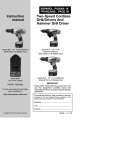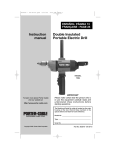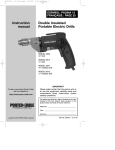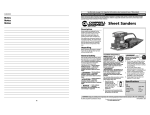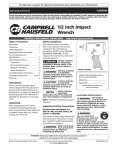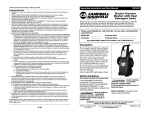Download Campbell Hausfeld Drill Owner`s manual
Transcript
See Warranty on page 8 for important information about commercial use of this product. DX111425CD & DX151905CD Limited Warranty 1. DURATION: From the date of purchase by the original purchaser as follows: One Year. 2. WHO GIVES THIS WARRANTY (WARRANTOR): Campbell Hausfeld / Scott Fetzer Company, 100 Production Drive, Harrison, Ohio, 45030, Telephone: (800) 424-8936 3. WHO RECEIVES THIS WARRANTY (PURCHASER): The original purchaser (other than for purposes of resale) of the Campbell Hausfeld product. 4. WHAT PRODUCTS ARE COVERED BY THIS WARRANTY: Any Campbell Hausfeld cordless power tool supplied or manufactured by Warrantor. 5. WHAT IS COVERED UNDER THIS WARRANTY: Substantial defects in material and workmanship which occur within the duration of the warranty period. 6. WHAT IS NOT COVERED UNDER THIS WARRANTY: A. Implied warranties, including those of merchantability and FITNESS FOR A PARTICULAR PURPOSE ARE LIMITED FROM THE DATE OF ORIGINAL PURCHASE AS STATED IN THE DURATION. If this product is used for commercial, industrial or rental purposes, the warranty will apply for ninety (90) days from the date of purchase. Some States do not allow limitation on how long an implied warranty lasts, so the above limitations may not apply to you. B. ANY INCIDENTAL, INDIRECT, OR CONSEQUENTIAL LOSS, DAMAGE, OR EXPENSE THAT MAY RESULT FROM ANY DEFECT, FAILURE, OR MALFUNCTION OF THE CAMPBELL HAUSFELD PRODUCT. Some States do not allow the exclusion or limitation of incidental or consequential damages, so the above limitation or exclusion may not apply to you. C. Any failure that results from an accident, purchaser’s abuse, neglect or failure to operate products in accordance with instructions provided in the owner’s manual(s) supplied with product. Accident, purchaser’s abuse, neglect or failure to operate products in accordance with instructions shall also include the removal or alteration of any safety devices. If such safety devices are removed or altered, this warranty is void. D. Normal adjustments which are explained in the owner’s manual(s) provided with the product. E. Items or service that are normally required to maintain the product, i.e. contacts, grips, springs, triggers or any other expendable part not specifically listed. These items will only be covered for ninety (90) days from date of original purchase. 7. RESPONSIBILITIES OF WARRANTOR UNDER THIS WARRANTY: Repair or replace, at Warrantor’s option, products or components which are defective, have malfunctioned and/or failed to conform within duration of the warranty period. 8. RESPONSIBILITIES OF PURCHASER UNDER THIS WARRANTY: A. Provide dated proof of purchase and maintenance records. B. Call Campbell Hausfeld (800-424-8936) to obtain your warranty service options. Freight costs must be borne by the purchaser. C. Use reasonable care in the operation and maintenance of the products as described in the owner’s manual(s). 9. WHEN WARRANTOR WILL PERFORM REPAIR OR REPLACEMENT UNDER THIS WARRANTY: Repair or replacement will be scheduled and serviced according to the normal work flow at the servicing location, and depending on the availability of replacement parts. This Limited Warranty applies in the United States, Canada and Mexico only and gives you specific legal rights. You may also have other rights which vary from state to state or country to country. Operating Instructions and Parts Manual DX111425CD & DX151905CD Please read and save these instructions. Read carefully before attempting to assemble, install, operate or maintain the product described. Protect yourself and others by observing all safety information. Failure to comply with instructions could result in personal injury and/or property damage! Retain instructions for future reference. BUILT TO LAST Cordless Drill/Driver and Charger Unpacking When unpacking this product, carefully inspect for any damage that may have occurred during transit. General Safety Information This manual contains information that is very important to know and understand. This information is provided for SAFETY and to PREVENT EQUIPMENT PROBLEMS. To help recognize this information, observe the following symbols. Danger indicates ! an imminently hazardous situation which, if not avoided, will result in death or serious injury. DANGER Warning indicates a potentially hazardous situation which, if not avoided, could result in death or serious injury. ! WARNING Model DX151905CD - Two Speed Ranges & variable speed trigger Caution indicates a ! potentially hazardous situation which, if not avoided, may result in minor or moderate injury. CAUTION Notice indicates important information, that if not followed, may cause damage to equipment. NOTICE The following safety precautions must be followed at all times along with any other existing safety rules. 1. Read all manuals included with this product carefully. Be thoroughly familiar with the controls and the proper use of the equipment. MANUAL 2. Only persons well acquainted with these rules of safe operation should be allowed to use this tool. Model DX111425CD - Single speed range & variable speed trigger REMINDER: Keep your dated proof of purchase for warranty purposes! Attach it to this manual or file it for safekeeping. © 2006 Campbell Hausfeld/Scott Fetzer 8 For parts, product & service information visit www.chpower.com IN708800AV 6/06 DX111425CD & DX151905CD Operating Instructions and Parts Manual General Safety Information (Cont’d.) WORK AREA Do not operate a ! power tool in an explosive atmosphere, such as in the presence of flammable liquids, gases, or dust. Power tools create sparks which may ignite the fumes or dust. WARNING Keep work area ! clean and well lighted. Cluttered benches and dark areas invite accidents. CAUTION Keep bystanders, ! children, and visitors away while operating a power tool. Distractions can cause you to lose control. CAUTION ELECTRICAL SAFETY Recharge this battery-operated tool only with the charger specified for the battery. A charger suitable for one type of battery can create a risk of fire when used with another battery. ! WARNING Do not expose ! power tools to rain or wet conditions. Water entering a power tool will increase the risk of electric shock. WARNING Use this battery! operated tool only with its designated battery pack. Use of any other batteries may create a risk of fire. WARNING Avoid body contact with grounded surfaces such as pipes, radiators, ranges, and refrigerators. There is an increased risk of electric shock if your body is grounded. ! WARNING PERSONAL SAFETY CALIFORNIA PROPOSITION 65 You can ! create dust when you cut, sand, drill or grind materials such as wood, paint, metal, concrete, cement, or other masonry. This dust often contains chemicals known to cause cancer, birth defects, or other reproductive harm. Wear protective gear. DANGER This product or its ! power cord contains lead, a chemical known to the State of California to cause cancer and birth defects or other reproductive harm. Wash hands after handling. WARNING Do not misuse this ! product. Excessive exposure to vibration, work in awkward positions, and repetitive work motions can cause injury to hands and arms. Stop using any tool if discomfort, numbness, tingling, or pain occur, and consult a physician. WARNING 1. Stay alert, watch what you are doing, and use common sense when operating a power tool. Do not use tool while tired or under the influence of drugs, alcohol, or medication. A moment of inattention while operating power tools may result in serious personal injury. Avoid accidental ! starting. Be sure switch is in the locked or off position before inserting battery pack, making any adjustments, changing accessories, or storing the tool. Carrying tools with your finger on the switch or inserting the battery pack into a tool with the switch on invites accidents. CAUTION 2. Remove adjusting keys or wrenches before turning on the tool. A key or wrench attached to a rotating part of the tool may result in personal injury. 3. Do not overreach. Keep proper footing and balance at all times. Proper footing and balance enable better control of the tool in unexpected situations. 4. Always work in a well-ventilated area. Wear an OSHA-approved dust mask and safety glasses. 5. Hold tool by insulated gripping surface when performing an operation where the tool may contact hidden wiring. Contacting a “live” wire will make exposed metal parts of the tool “live” and shock the operator. 6. Keep hands away from rotating parts. 7. Use clamps or another practical way to secure the workpiece to a stable platform. Never hold work in your hand, lap, or against other parts of your body when cutting. 8. Do not wear loose fitting clothing, scarves, or neck ties in work area. Loose clothing may become caught in moving parts and result in serious personal injury. 9. Do not wear jewelry when operating any tool. Jewelry may become caught in moving parts and result in serious personal injury. Notes TOOL USE AND CARE Do not use tool if ! switch does not turn it on or off. Any tool that cannot be controlled with the switch is dangerous and must be repaired. WARNING Ensure the switch is ! in the off position before inserting battery pack. Inserting the battery pack into the saw with the switch on invites accidents. WARNING \ Under abusive ! conditions, liquid may be ejected from the battery. Avoid contact. If contact accidentally occurs, flush with water. If liquid contacts eyes, seek medical help. Liquid ejected from the battery may cause irritation or burns. WARNING 1. When battery pack is not in use, keep it away from metal objects such as paper clips, coins, keys, nails, or screws that can make a connection from one terminal to another. Shorting the battery terminals together may cause sparks, burns, a fire, or damage to the battery. 2. This tool must NOT be modified or used for any application other than that for which it was designed. Do not force the ! tool. Use the correct tool for your application. The correct tool will do the job better and safer at the rate for which it is designed. CAUTION 3. Maintain tools with care. Keep tools clean. Properly maintained tools with sharp cutting edges are less likely to bind and are easier to control. 4. Check for misalignment or binding of moving parts, breakage of parts, and any other condition that may affect the tool’s operation. If damaged, have the tool serviced before using. Many accidents are caused by poorly maintained tools. Maximum Size Drill Bits Drill Model Max. Bit Size DX111425CD 3/8” (10 mm) DX151905CD 3/8” (10 mm) www.chpower.com 2 7 Operating Instructions and Parts Manual Operation (Cont’d.) 9. Combination pilot drill, shank drill and countersink bits are available from local supply houses for drilling holes in one easy operation. DRIVING SELF-TAPPING SCREWS 1. Drill pilot hole of correct size as recommended by screw manufacturer for fastener being used. 2. Install proper screwdriver bit. 3. Set torque adjusting collar for desired torque and set speed selector to “1,” the low-speed setting. 4. Set drill for correct rotation. 5. Position bit in head of screw. 6. Place end of screw into pre-drilled hole, remove fingers, start drill and drive screw. 7. As soon as screw has seated, release trigger, and lift drill from screw. DX111425CD & DX151905CD DRIVING MACHINE SCREWS 1. Drill and tap correct hole size for fastener to be used. 2. Start screw in hole with fingers and drive as outlined under DRIVING WOOD SCREWS. TO REMOVE SCREWS 1. Set torque adjusting collar for maximum torque and set speed selector to LOW. 2. Install proper screwdriver bit. 3. Set screwdriver for reverse rotation. 4. Place bit in screw and start drill to remove screw. Maintenance KEEP TOOL CLEAN All plastic parts should be cleaned with a soft damp cloth. NEVER use solvents to clean plastic parts. They could very possibly dissolve or otherwise damage the material. FAILURE TO START Should your tool fail to start, make sure battery pack is charged and installed in drill. BATTERY The battery pack will discharge by itself without damage if stored for long periods of time, and may require recharging before use. TECHNICAL SERVICE For information regarding the operation or repair of this product, please call 1800-251338. Tool service must ! be performed only by qualified repair personnel. Service or maintenance performed by unqualified personnel could result in a risk of injury. CAUTION create a risk of fire when used with another battery. General Safety Information (Cont’d.) 5. Use only accessories that are recommended by the manufacturer for your model. Accessories suitable for one tool may create a risk of injury when used on another tool. 6. Some wood contains preservatives which can be toxic. Take extra care to prevent inhalation and skin contact when working with these materials. Request and follow all safety information available from your material supplier. 7. Store tools out of reach of children and other untrained persons. Tools are dangerous in the hands of untrained users. 8. This tool must NOT be modified or used for any application other than that for which it was designed. 9. Do not use if chuck jaws or other parts are cracked or worn. 10. Verify the drill’s rotation before starting to drill, so it is correct for the operation being performed. 11. Do not use drill as a router or try to elongate or enlarge holes by twisting the drill. Drill bits may break and cause injury. Each drill is equipped with a chuck capable of handling bits up to a certain size – see chart titled “Maximum Size Drill Bits.” Do not use bits larger than those recommended. NOTICE For Replacement Parts or Technical Assistance, call 1800-251338 Description Part Number Charger – 19.2V DC / 240 VAC, Australia SV566900AV Battery Pack – 19.2V DC / 240 VAC, Australia DG101000PY Charger – 14.4V DC / 240 VAC, Australia SV567000AV Battery Pack – 14.4V DC / 240 VAC, Australia DG016800PY Chuck – 3/8" DG012100PI Set Screw SV446100AV Case DG015600TC Please provide following information: - Model number - Serial number (if any) - Part description and number as shown in parts list Address any correspondence to: Campbell Hausfeld Attn: Customer Service 100 Production Drive Harrison, OH 45030 U.S.A. Safety Instructions for Charger and Batteries ELECTRICAL SAFETY Before using battery charger, read all instructions on battery charger, battery pack, and product. 1. A battery-operated tool with integral batteries or a separate battery pack must be recharged only with the specified charger for the battery. A charger that may be suitable for one type of battery may Up to 24 volts DC ! present at charging terminals. Do not probe with conductive objects. Danger of electrical shock or electrocution. If battery pack case ! is cracked or damaged, do not insert into charger. Danger of electrical shock or electrocution. DANGER DANGER Avoid body contact ! with grounded surfaces such as pipes, radiators, ranges, and refrigerators. There is an increased risk of electric shock if your body is grounded. WARNING Charger plugs must ! match the outlet. Never modify the plug in any way. Do not use adapter plugs with grounded chargers. Unmodified plugs and matching outlets will reduce the risk of electric shock. WARNING ! WARNING Do not abuse cord. • Never carry charger by its cord. • Never pull the cord to disconnect from receptacle. Pull charger case rather than cord when disconnecting charger. 2. Do not operate charger with damaged cord or plug. • Have a damaged or worn power cord and/or strain relief replaced immediately. • Do not attempt to repair power cord. 3. Make sure cord is located so that it will not be stepped on, tripped over, or otherwise subjected to damage or stress. 4. Do not operate charger if it has received a sharp blow, been dropped, or otherwise damaged. Take it to a qualified serviceman. 5. Do not disassemble charger or battery pack. Take it to a qualified serviceman when service or repair is required. Incorrect reassembly may result in a risk of electric shock or fire. 6. Do not use an extension cord unless absolutely necessary. Use of improper extension cord could result in a risk of fire and electric Minimum Wire Size (AWG) of Extension Cord for Battery Charger Length of Cord in Feet 25 50 100 150 AWG Size of Cord 18 18 18 16 shock. If an extension cord must be used, make sure: • That the size of the cord is at least as specified in chart titled “Minimum Wire Size (AWG) of Extension Cord for Battery Charger.” • That the pins on plug of extension cord are the same number, size and shape as those of plug on charger. • That the extension cord is properly wired and in good electrical condition. • If an extension cord is to be used outdoors it must be marked with the suffix “W-A” or “W” following the cord type designation to indicate it is acceptable for outdoor use. For example – SJTW-A 7. Unplug charger from outlet before attempting any maintenance or cleaning. 8. Charge the battery pack in a wellventilated area. Do not allow any object to cover the charger and/or battery pack while charging. 9. Do not store the charger or battery pack in locations where the temperature may reach or exceed 105°F (40°C), such as a metal tool shed, or a car in the summer. This can lead to deterioration of the storage battery. 10. For optimal charging of the battery pack, charge it in temperatures between 65°-75° F (18°-24°C). Do not charge the battery pack in an air temperature below 40°F (4° C), or above 105°F (40° C). Charging the battery outside of this range can adversely affect battery performance. 11. Do not charge battery in damp or wet locations. 12. Do not charge battery pack if it feels hot to the touch. Wait for it to cool. 13. Do not expose charger to rain, snow or frost. 14. Do not incinerate battery pack. It can explode in a fire. 15. Battery charger is not intended for any other uses other than charging the rechargeable battery. Any other uses may result in risk of fire, electrical shock, or electrocution. 16. The charger is ventilated through slots in the top and the bottom of the housing. Do not block the ventilation slots or place in a location where ventilation slots may become blocked. Intense heat and risk of fire may result. www.chpower.com 6 3 Operating Instructions and Parts Manual Safety Instructions for Charger and Batteries (Cont’d.) BATTERY DISPOSAL Do not attempt to disassemble the battery or remove any component projecting from the battery terminals. Fire or injury may result. Prior to disposal, protect exposed terminals with heavy insulating tape to prevent shorting. ! WARNING NICKEL-CADMIUM BATTERY • If equipped with a nickel-cadmium battery, the battery must be recycled or disposed of in an environmentally sound manner. Check with your county’s Public Works Department for information on recycling batteries. Charging Battery REMOVING BATTERY PACK Before charging, remove battery pack from Drill/Driver by depressing the battery release button and pulling the battery pack out of tool. GENERAL INSTRUCTIONS With normal use, as battery pack approaches the discharged state, you will notice a sharp drop in tool performance. When the tool is unable to perform the task at hand, it is time to recharge the battery pack. Recharging the battery pack before this condition is reached will reduce DX111425CD & DX151905CD the total work life of the pack. Discharging the pack beyond this point can damage the pack. NOTE: Battery temperature will increase during and shortly after use. Batteries may not accept a full charge if they are charged immediately after use. Do not charge battery pack if it feels hot to the touch. Wait for it to cool. INITIAL CHARGING Before using the cordless Drill/Driver for the first time, charge the battery fully. Depending on room temperature and line voltage, the battery should be fully charged in six (6) to ten (10) hours. CHARGING Connect the current carrying prongs on the power cord to a 230V / 240V AC 50Hz wall outlet. Connect the other end of the power cord to the battery pack. If the charger is equipped with an LED, a red light will light up as long as the battery pack is connected to the charger and the charger is plugged in. With normal use, the battery pack will be fully charged after about three (3) to six (6) hours. Disconnect charger from power source when not in use. IMPORTANT: THE BATTERY PACK SHOULD NOT BE LEFT ON THE CHARGER FOR MORE THAN FORTY-EIGHT (48) HOURS. Operation VARIABLE-SPEED TRIGGER SWITCH (some models) If your Drill/Driver is equipped with a variable-speed trigger switch, the pressure you apply to the trigger controls the tool speed. Apply more pressure to increase the speed and release pressure to decrease speed. This accurate speed control allows you to drill without center-punching and to use the Drill/Driver as a power screwdriver. Bits are available for driving screws as well as running bolts and nuts. FORWARD/REVERSE BUTTON This Drill/Driver is equipped with a forward/reverse lever which is used to change the rotation of the chuck. Do not attempt to change the rotation unless the chuck is completely stopped. Moving the Forward/Reverse Button while chuck is rotating can damage the tool. NOTICE Charger and Battery For forward rotation, firmly press in on the lever marked FWD. For reverse rotation, firmly press in on the lever marked REV. TRIGGER LOCK To activate trigger lock, move the forward/reverse lever so it is centered in the handle. GEAR SHIFTING (DG151905CD only) The DG151905CD Drill/Driver is equipped with two separate gear ranges, low and high. Low gear provides high-torque and slower drilling speeds for heavy duty work or for driving screws. High gear provides faster speeds for drilling lighter work. To change speeds, slide switch to the high or low position. Actuate trigger slightly if the gear shift does not fully engage. Note: If Drill/Driver is running, but the chuck will not turn, check to make sure the gear shifting switch is pushed fully into desired setting. ADJUSTABLE CLUTCH This Drill/Driver features 16 clutch settings. Output torque will increase as the clutch ring is rotated from 1 to 16. 1 to 2 for driving small screws. 3 to 4 for driving screws into soft materials or plastics. 5 to 7 for driving screws into softwoods. 8 to 10 for medium woods. 11 to 14 for driving screws into medium / hard woods. 15 to 16 for driving screws into metal. The “drill” position locks up the clutch to permit heavy-duty drilling and driving work. It also allows bits to be changed quickly and easily in the keyless chuck. INSERTING BITS Move Forward/Reverse Button to the center “Off” position. Remove battery pack (See “Charging Battery” section) and rotate the clutch ring to the drill bit symbol. Rotate the chuck sleeve counterclockwise (viewing from chuck end), and open chuck to approximate drill bit diameter. Insert a clean bit up to the drill bit flutes for small bits, or as far as it will go for large bits. Close chuck by rotating the chuck sleeve clockwise and securely tighten by hand. Operation (Cont’d.) Do not use the power of the drill to loosen or tighten bit while holding chuck. The spinning chuck will cause friction burn or hand injury. ! CAUTION REMOVING CHUCK Remove battery pack. Rotate clutch ring to drill bit symbol and open chuck all the way. Turn left-hand-threaded screw inside chuck clockwise, and remove it . Insert the short arm of a 3/8" hex key wrench and close jaws on flats of wrench. Strike long arm of wrench sharply counterclockwise, remove wrench and unthread chuck from spindle. INSTALLING CHUCK To install chuck, reverse “Removing Chuck” procedure. Always keep the spindle threads, chuck threads, and securing screw free of debris. GENERAL DRILLING The front end of ! the Drill/Driver may be made “live” if the tool drills into live wiring in the wall. TO PREVENT ACCIDENTAL ELECTRICAL SHOCK, HOLD DRILL/DRIVER ONLY BY THE SOFT GRIP HANDLE. WARNING Safety ! glasses must be worn during operation. WARNING 1. Set torque adjusting collar for drilling operation and set speed selector to appropriate speed. 2. Be sure drill bit is securely gripped in chuck. 3. Set FORWARD/REVERSE BUTTON for clockwise rotation. Make sure work is ! held securely in a vice or clamped in place prior to starting drilling operation. Loose work may spin and cause bodily injury. CAUTION 4. Locate exact center for hole to be drilled and using a center punch, make a small dent in work. 5. Place tip of drill bit in dent made by center punch, hold drill square with work, and start the motor. Applying too ! much pressure may cause the bit to overheat or break, resulting in bodily injury or damaged drill bits. CAUTION Apply steady, even pressure to keep drill bit cutting. Too little pressure will keep the bit from cutting. Eventually, the excessive friction created by sliding over the surface will dull the cutting edges. Always be alert ! and brace yourself against the twisting action of the drill. CAUTION 6. If drill stalls or becomes jammed in the hole, release trigger immediately, remove drill bit from work and determine cause of stalling or jamming. Do not squeeze trigger on and off in an attempt to free a stalled or jammed drill. This will damage the motor. NOTICE The direction of rotation may be reversed to help free a jammed bit. Be sure direction of rotation is RESET before attempting to continue drilling. 7. Reduce the pressure on the drill just before the bit cuts through the work to avoid splintering wood or stalling in metal. 8. When bit has completely penetrated work and is spinning freely, withdraw it from the work while the motor is still running, then turn off drill. DRILLING WOOD In addition to the instructions listed under GENERAL DRlLLlNG, the following also apply: 1. When using a twist drill in wood, frequently withdraw it from the hole to clear away chips which build up in the flutes. This helps prevent overheating and burning work. 2. If a backing block is used to keep back of work from splintering, clamp it securely in place. If a backing block is not used with spade bits or hole saws, ease up pressure as soon as bit point breaks through work, and complete the hole from the opposite side. DRILLING METAL In addition to the instructions listed under GENERAL DRlLLlNG, the following also apply: 1. Use only good quality sharp high speed steel twist bits when drilling metal. 2. Start drilling with slow speed and gradually increase speed as drill cuts. The harder the material, the slower the speed required. The softer the material, the faster the speed. 3. When drilling a large hole, it is easier to first drill a smaller hole and then enlarge it to the required size. 4. The use of a lubricant, such as oil, on the drill point helps keep the bit cool, increases drilling action and prolongs drill bit life. 5. If possible, punch the drilling position first to prevent drill bit run away. DRIVING WOOD SCREWS 1. Drill pilot and shank clearance holes. See chart titled “Suggested Hole Sizes for Wood Screws.” 2. Install proper screwdriver bit. 3. Set torque adjusting collar for desired torque and set speed selector to “1,” the low-speed setting. 4. Set drill for correct rotation. 5. Start screw straight in hole with fingers. 6. Place bit on screw, start drill and exert pressure to drive screw. 7. As soon as screw has seated, release trigger, and lift screwdriver from screw. 8. A lubricant, such as soap or wax, may be used on screw threads for ease of driving. This is particularly important in hard wood. Suggested Hole Sizes For Wood Screws Screw Size Shank Drill Clearance Diameter #6 #8 #10 #12 5/32 11/64 13/64 15/64 Pilot Drill Diameter Soft Wood (.156) (.172) (.203) (.234) 1/16 5/64 3/32 7/64 www.chpower.com (.062) (.078) (.093) (.109) Hard Wood 5/64 3/32 7/64 1/8 (.078) (.093) (.109) (.125) www.chpower.com 4 5






